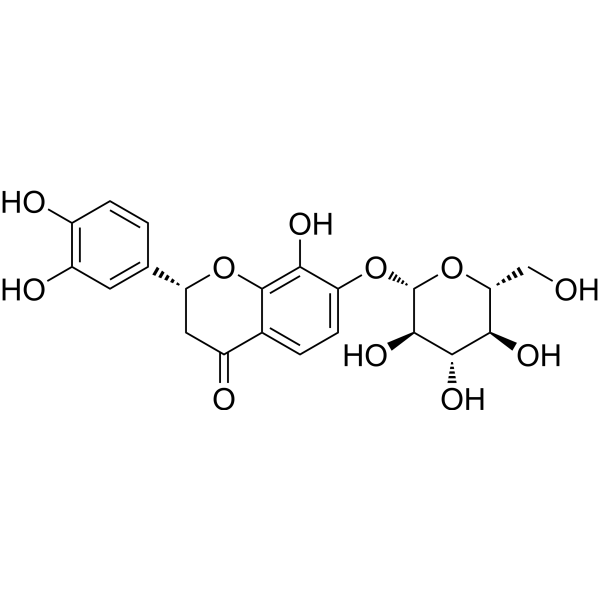2R-3',4',8-Trihydroxyflavanone-7-O-glucosideCAS# 56389-87-8 |

Quality Control & MSDS
Package In Stock
Number of papers citing our products

| Cas No. | 56389-87-8 | SDF | Download SDF |
| PubChem ID | N/A | Appearance | Powder |
| Formula | C21H22O11 | M.Wt | 450.39 |
| Type of Compound | Flavones/Flavanones | Storage | Desiccate at -20°C |
| Solubility | Soluble in Chloroform,Dichloromethane,Ethyl Acetate,DMSO,Acetone,etc. | ||
| General tips | For obtaining a higher solubility , please warm the tube at 37 ℃ and shake it in the ultrasonic bath for a while.Stock solution can be stored below -20℃ for several months. We recommend that you prepare and use the solution on the same day. However, if the test schedule requires, the stock solutions can be prepared in advance, and the stock solution must be sealed and stored below -20℃. In general, the stock solution can be kept for several months. Before use, we recommend that you leave the vial at room temperature for at least an hour before opening it. |
||
| About Packaging | 1. The packaging of the product may be reversed during transportation, cause the high purity compounds to adhere to the neck or cap of the vial.Take the vail out of its packaging and shake gently until the compounds fall to the bottom of the vial. 2. For liquid products, please centrifuge at 500xg to gather the liquid to the bottom of the vial. 3. Try to avoid loss or contamination during the experiment. |
||
| Shipping Condition | Packaging according to customer requirements(5mg, 10mg, 20mg and more). Ship via FedEx, DHL, UPS, EMS or other couriers with RT, or blue ice upon request. | ||

2R-3',4',8-Trihydroxyflavanone-7-O-glucoside Dilution Calculator

2R-3',4',8-Trihydroxyflavanone-7-O-glucoside Molarity Calculator
| 1 mg | 5 mg | 10 mg | 20 mg | 25 mg | |
| 1 mM | 2.2203 mL | 11.1015 mL | 22.203 mL | 44.406 mL | 55.5074 mL |
| 5 mM | 0.4441 mL | 2.2203 mL | 4.4406 mL | 8.8812 mL | 11.1015 mL |
| 10 mM | 0.222 mL | 1.1101 mL | 2.2203 mL | 4.4406 mL | 5.5507 mL |
| 50 mM | 0.0444 mL | 0.222 mL | 0.4441 mL | 0.8881 mL | 1.1101 mL |
| 100 mM | 0.0222 mL | 0.111 mL | 0.222 mL | 0.4441 mL | 0.5551 mL |
| * Note: If you are in the process of experiment, it's necessary to make the dilution ratios of the samples. The dilution data above is only for reference. Normally, it's can get a better solubility within lower of Concentrations. | |||||

Calcutta University

University of Minnesota

University of Maryland School of Medicine

University of Illinois at Chicago

The Ohio State University

University of Zurich

Harvard University

Colorado State University

Auburn University

Yale University

Worcester Polytechnic Institute

Washington State University

Stanford University

University of Leipzig

Universidade da Beira Interior

The Institute of Cancer Research

Heidelberg University

University of Amsterdam

University of Auckland

TsingHua University

The University of Michigan

Miami University

DRURY University

Jilin University

Fudan University

Wuhan University

Sun Yat-sen University

Universite de Paris

Deemed University

Auckland University

The University of Tokyo

Korea University
- Polyporoid C
Catalog No.:BCX1722
CAS No.:1042362-47-9
- Polyporoid B
Catalog No.:BCX1721
CAS No.:1042362-45-7
- Maritimetin
Catalog No.:BCX1720
CAS No.:576-02-3
- Aristol-1(10)-en-9-ol
Catalog No.:BCX1719
CAS No.:114339-94-5
- (2E,4E)-8-Hydroxy-2,7-dimethyl-decadien-(2,4)-disaeure-(1,10)-dioic acid
Catalog No.:BCX1718
CAS No.:2808401-10-5
- Angulatin K
Catalog No.:BCX1717
CAS No.:1631992-80-7
- Rabdophyllin G
Catalog No.:BCX1716
CAS No.:82460-75-1
- Wallichoside
Catalog No.:BCX1715
CAS No.:60657-36-5
- 2,3-Dihydro-3-hydroxy-2-oxo-1H-indole-3-acetic acid
Catalog No.:BCX1714
CAS No.:57061-17-3
- Protoapigenin
Catalog No.:BCX1713
CAS No.:879325-07-2
- 2-(trans-1,4-dihydroxy-cyclohexyl)-5,7-dihydroxy-chromone
Catalog No.:BCX1712
CAS No.:1270013-29-0
- Protoapigenin 4'-O-β-D-glucoside
Catalog No.:BCX1711
CAS No.:163559-04-4
- 2',3'-Dihydro-2'-hydroxyprotoapigenone
Catalog No.:BCX1724
CAS No.:1365655-88-4
- Angulatin B
Catalog No.:BCX1725
CAS No.:142546-07-4
- Celangulin XIX
Catalog No.:BCX1726
CAS No.:403505-80-6
- Arabidopyl alcohol
Catalog No.:BCX1727
CAS No.:1400234-92-5
- 1α, 2α-diacetoxy-8β-isobutanoyloxy-9α-benzoyloxy-15-β-(β-furancarbonyloxy)-4β, 6β-dihydroxy-β-dihydr...
Catalog No.:BCX1728
CAS No.:2170562-63-5
- Phaseic acid
Catalog No.:BCX1729
CAS No.:24394-14-7
- (2E,4E)-2,4-Decadienoic acid
Catalog No.:BCX1730
CAS No.:30361-33-2
- Isochavicine
Catalog No.:BCX1731
CAS No.:30511-77-4
- Piperundecalidine
Catalog No.:BCX1732
CAS No.:88660-11-1
- 15α-Hydroxy-20-oxo-6,7-seco-ent-kaur-16-en-1,7α(6,11α)-diolide
Catalog No.:BCX1733
CAS No.:1355450-84-8
- Celangulatin D
Catalog No.:BCX1734
CAS No.:1000784-45-1
- Retrofractamide A
Catalog No.:BCX1735
CAS No.:94079-67-1
Comparison of antioxidant activities of different parts from snow chrysanthemum (Coreopsis tinctoria Nutt.) and identification of their natural antioxidants using high performance liquid chromatography coupled with diode array detection and mass spectrometry and 2,2'-azinobis(3-ethylbenzthiazoline-sulfonic acid)diammonium salt-based assay.[Pubmed:26521095]
J Chromatogr A. 2016 Jan 8;1428:134-42.
Snow chrysanthemum (Coreopsis tinctoria Nutt.), a world-widely well-known flower tea material, has attracted more and more attention because of its beneficial health effects such as antioxidant activity and special flavor. In this study, a high performance liquid chromatography coupled with diode array detection and mass spectrometry (HPLC-DAD-MS) and 2,2'-azinobis(3-ethylbenzthiazoline-sulfonic acid)diammonium salt (ABTS) based assay was employed for comparison and identification of antioxidants in different samples of snow chrysanthemum. The results showed that snow chrysanthemum flowers possessed the highest while stems presented the lowest antioxidant capacities. Fourteen detected peaks with antioxidant activity were temporarily identified as 3,4',5,6,7-pentahydroxyflavanone-O-hexoside, chlorogenic acid, 2R-3',4',8-trihydroxyflavanone-7-O-glucoside, flavanomarein, flavanocorepsin, flavanokanin, quercetagitin-7-O-glucoside, 3',5,5',7-tetrahydroxyflavanone-O-hexoside, marein, maritimein, 1,3-dicaffeoylquinic acid, coreopsin, okanin and acetyl-marein by comparing their UV spectra, retention times and MS data with standards or literature data. Antioxidants existed in snow chrysanthemum are quite different from those reported in Chrysanthemum morifolium, a well-known traditional beverage in China, which indicated that snow chrysanthemum may be a promising herbal tea material with obvious antioxidant activity.


